| |
Glossary of Coral Reef Terminology - T
T cell - one type of white blood cell that attacks virus-infected cells, foreign cells, and cancer cells. T cells also produce a number of substances that regulate the immune response; also called "T lymphocyte." T stands for the thymus gland, where T lymphocytes mature |
T cell receptor - an antigen-binding protein, located on the surfaces of CTLs (cytotoxic or killer T cells); a transmembrane protein on the surface of T cells that recognizes antigens associated with MHC proteins on the surface of phagocytes |
t-test - a statistical procedure for testing the difference between two or more means. It is used for estimating the probability that the means have been drawn from the same or different populations |
t. - according to; on the evidence of (teste) |
t. c. - in the volume cited (tomus citate) |
table reef - an isolated flat-topped coral reef which reaches the surface but lacks a lagoon |
tabula - a horizontal partition (or floor) dividing the corallite skeleton; one in a series of horizontal plates traversing a coral with a massive calcareous skeleton. The polyps extend only down to topmost tabula |
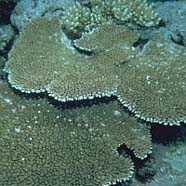
Coral (Acropora) having a tabulate shape.
|
tabulate - having a flat surface |
tachyauxesis - rapid growth; a part or structure that grows at a quicker rate than the organism as a whole |
tactile - pertaining to information, interpretations, and behavior derived from the sense of touch |
tactile comb - a sensory projection on the umbrella margin of a medusa. It bears long, stiff hairs |
taeniform - ribbon-like; elongate, compressed and deep-bodied |
tagging - an identification system involving various methods (fin clipping, coloring, biotelemetry, radioactive markers, tattooing, branding, tagging, etc.), used for individual identification and for studies on movement, growth and other biological activities; also called "marking" |
Taino - Pre-Columbian indigenous inhabitants of the Bahamas, Greater Antilles and the northern Lesser Antilles |
talus slope - a synonym of reef base |
Tanaidacea - a minor order of small (1 mm–2 cm in length) crustaceans in the class Malacostraca. Of the approximately 1000 species, most are marine, but some are found in coastal freshwater and estuarine habitats. They are among the most diverse and abundant animals in some marine environments. Most species are benthic, although some species may be planktonic. They are found at a wide variety of depths, from the littoral zone to deep waters, in all oceans of the world, from tropical to temperate, and even in polar regions |
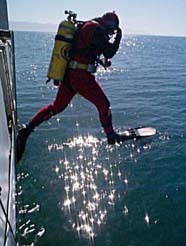
A NOAA diver breathing compressed air from the steel scuba tank (or cylinder) attached to his BCD (buoyancy control device). The diver is entering the water using the giant step technique. (Photo: NOAA National Undersea Research Program)
|
tank - a hollow steel or aluminum cylinder, used to contain compressed air or other breathing gas mixtures used by scuba divers for an air supply; also called a cylinder or bottle |
taphonomy - the study of everything that happens to an organism’s body after it dies; includes probable cause and manner of death, movement of the body, chemical and physical alteration, burial, decomposition, diagenesis and fossilization |
target - in genomics, the DNA or RNA being hybridized to a microarray; for diagnostic tests, the molecule or nucleic acid sequence that is being sought in a sample |
taro - a tropical food plant whose potato-like root is the basis for poi, a staple of Polynesian cooking |
taro patch - a flooded terrace or pond field used for growing taro, an edible plant grown for its tuberous root and vitamin-rich leaves |
tau - the third charged lepton (in order of increasing mass), with electric charge -1 |
tautonymy - in taxonomy, the use of the same word for the name of a genus-group taxon and for one of its included species or subspecies |
Tautra reef - one of the world’s shallowest deep-water coral reefs, located in Norwegian waters at only 39 meters water depth |
tawny - brownish yellow color |
taxis - an innate behavioral response to a directional stimulus (a stimulus from a particular direction) whereby the organism either moves toward (positive taxis) or away (negative taxis) from the stimulus |
taxocene - a taxonomically related set of species within a community that have similar ecological functions |
taxol - a pharmaceutical, derived from the yew tree, which is a potent anti-tumor drug |
taxon - a taxonomic group or entity |
taxonomic group - a taxon with all its subordinate taxa and their individuals; e.g. the taxonomic group Crustacea consists of all crustaceans and their taxa |
taxonomic group - a taxon with all its subordinate taxa and their individuals; e.g., the taxonomic group Crustacea consists of all crustaceans and their taxa |
taxonomic key - a tabulation of diagnostic characters of taxa in dichotomous couplets to facilitate rapid identification |
taxonomy - the science and methodology of classifying organisms based on physical and other similarities. Taxonomists classify all organisms into a hierarchy, and give them standardized Latin or Latinized names. There are seven main levels of classification in the hierarchy. They are, from most to least inclusive: Kingdom; Phylum (or Division for algae, fungi, and plants); Class; Order; Family; Genus; and Species. Taxonomists describe new species, classify organisms, and study speciation, the evolution of new species |
teal - greenish blue color |
technology - the creation of products and processes for the purpose of improving human chances for survival, comfort level, and quality of life |
technology transfer - the process of transferring discoveries made by basic research institutions, such as universities and government laboratories, to the commercial sector for development into useful products and services |
tectal - pertaining to the roof of a structure, e.g. the top of the head or brain |
teleost - a large group of fishes (infraclass Teleostei) which contains most of the bony fishes |
telolecithal - an egg cell in which the yolk is not evenly distibuted throughout the cytoplasm, but is concentrated in one location, and cleavage is incomplete, e.g., a bird egg |
telomere - the terminal part of a eukaryotic chromosome. These specialised structures are involved in the replication and stability of linear DNA molecules. In vertebrate cells, each telomere consists of thousands of repetitive copies of the same DNA sequence. Telomeres shorten each time a cell divides; when one or more telomeres reaches a minimum critical length, cell division stops, signaling cell senescence. This mechanism limits the number of times a cell can divide |

The telson, flanked by uropods, is the central part of the tail fan. (Graphic: Maine Department of Marine Resources)
|
telson - the terminal joint or movable piece at the end of the abdomen of crustaceans; middle piece of the tail fan |
temperate - region in which the climate undergoes seasonal change in temperature and moisture. Temperate regions of the earth lie primarily between 30 and 60 degrees latitude in both hemispheres |
template - a molecule that serves as the pattern for synthesizing another molecule ; in the process of replication or transcription, the strand of DNA that serves as the source of information |
temporal niche - the functional position of an organism in its environment as determined by the periods of time during which it occurs and is active there |
temporary threshold shift - in mammals, a temporary increase in the threshold of hearing (minimum intensity need to hear a sound) at a specific frequency that returns to its pre-exposure level over time |
tendril - a slender elongated thread-like organ which may cling to objects for support |
tendriliform - having the form or shape of a tendril |

Tentacles of a sea anemone. Each tentacle contains stinging cells (nematocysts) used for defense and food capture. (Photo: Dr. Anthony Picciolo)
|
tentacle - a finger-like evagination of the body wall. Tentacles surround the mouths of coral polyps, anemones and other invertebrates. They are used for capturing prey, defense, reproduction, gas exchange, and light absorption |
tentacle-tube-foot suspension feeder - a suspension feeder that traps particles on distinct tentacles or tube feet (in echinoderms) |
tentacular bulb - the expanded base of a medusa's tentacle. It functions in digestion and nematocyst formation; also called " ocellar bulb" |
tentacular lobe - a lobe at the point of insertion (beginning) of a septum |
tentacular sheath - one of the two cavities in the sides of the body of ctenophores (comb jellies) into which the tentacles can be withdrawn |
tentaculozooid - a dactylozooid (a colonial hydrozoan polyp that possesses a large, nematocyst-bearing fishing tentacle, and functions in defense and in food capture) |
tera - a metric prefix meaning 10 to the 12th power, or one trillion |
terabyte - a measure of data size. A terabyte of data is equivalent to 1,000 gigabytes of data or 1,000,000 megabytes of data. One petabyte equals 1,000 terabytes |
teratogen - a chemical or other factor that specifically causes abnormalities during embryonic growth and development |
terete - round in cross-section and tapering |
tergite - a hard plate (sclerite) forming one of the constituents of the dorsal exoskeleton (tergum) of an animal, such as an arthropod |
tergum - the back of an animal |
terminal - at the end position |
terminal male - in fishes, a supermale; the dominant male |
terminal taxon - one of the units of a phylogenetic tree whose collective phylogeny is reconstructed, i.e., the undivided tips of a tree (usually contemporary taxa). Terminals may be higher taxa, species, populations, individuals, fossils or even genes |
terminator - a sequence of DNA bases that stops RNA polymerase from synthesizing RNA |
ternary diagram - a triangular graph used to plot percentages of each of three components (e.g., sand, silt, and clay) which sum to a constant. Each apex is considered 100% of one component. It graphically depicts the ratios of the three variables as positions in an equilateral triangle; also called a ternary plot, ternary graph, triangle plot, simplex plot, or de Finetti diagram |
ternary name - in taxonomy, the trinomen |
terpenoid - a class of organic compound produced by soft corals for defense and for aggressive colonization of new substrates |
terri - a prefix meaning "earth" |
territoriality - the defense of a given area |
territory - an area over which an animal establishes jurisdiction. The area is defended and no other individuals of the same species, and often of other species, are allowed inside, except for prospective breeding partners during a reproductive bout |
Territory (Office of Insular Affairs) - an incorporated United States insular area, of which only one exists currently, Palmyra Atoll. With an area of 1.56 square miles, Palmyra consists of about fifty small islands and lies approximately one thousand miles south of Honolulu, HI |
territory (OIA) - an unincorporated United States insular area, of which there are currently thirteen, three in the Caribbean (Navassa Island, Puerto Rico and the United States Virgin Islands) and ten in the Pacific (American Samoa, Baker Island, Guam, Howland Island, Jarvis Island, Johnston Atoll, Kingman Reef, Midway Atoll, the Northern Mariana Islands and Wake Atoll) |
tertiary consumer - a carnivore which eats other carnivores |
TESS (Threatened and Endangered Species System) - the USFWS Threatened and Endangered Species System (TESS) is a list of threatened and endangered animals and plants native to the United States, and the outlying Areas of the United States, the Freely Associated States, and trust Territory |
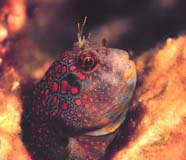
A tessellated blenny. (Photo: NOAA)
|
tessellated - a checkered appearance |
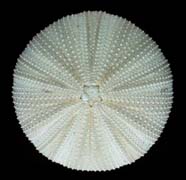
Dorsal view of sea urchin test.
|
test - shell or hard outer covering of echinoderms and ascidians |
test animal - an individual used for experimental research purposes |
tetraspore - a haploid spore in the red algae life cycle which is the meiotic product of the tetrasporangium of a diploid tetrasporophyte. The tetraspores are released, settle, and grow into gametophytes |
tetrasporophyte - diploid phase in the life cycle of red algae which produces haploid tetraspores.The tetrasporophyte is the site of meiosis, more specifically, the tetrasporangia where haploid tetraspores are produced. These tetraspores are released, settle, and grow into the gametophyte, completing the basic red algal life history |
tetraxon - in sponges, a spicule with four rays |
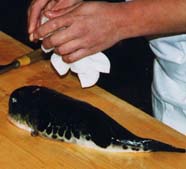
A specially licensed Japanese chef prepares fugu, the ever-so-slightly tainted fillet of the extremely poisonous blowfish, whose internal organs contain tetrodotoxin.
|
tetrodotoxin (TTX) - tetrodotoxin (TTX) is an especially potent marine neurotoxin, named after the order of fish from which it is most commonly associated, the Tetraodontiformes (includes the puffers, porqupine fish, blowfish, cowfish, boxfish).The toxin appears in high concentrations in the gonads, liver, intestines and skin of pufferfish. The fatality rate when injested may be as high as 60 percent. Tetradotoxin is more than 10,000 times deadlier than cyanide. Other marine and terrestrial organisms have been found to store TTX, for example, the Australian blue-ringed octopus, parrotfish, triggerfish, gobies, angelfish, ocean sunfish, globefish, seastars, starfish, xanthid and other crabs, a horseshoe crab, a number of marine snails, flatworms, tunicates, ribbonworms, mollusks and marine algae (Jania spp.) Terrestrial organisms include the Harlequin frogs (Atelopus spp.), three species of California newt and other eastern salamanders |
Texas Automated Buoy System (TABS) - Texas A & M University’s Geochemical and Environmental Research Group (GERG) operates two data buoys near the Flower Garden Banks National Marine Sanctuary at Sites N and V. The buoys measure winds, air temperature and humidity, atmospheric pressure, conductivity, and surface currents and report the data in near real time though the Texas Automated Buoy System |
thallus - the vegetative body of a plant or alga that is not differentiated into organs, such as roots,stems and leaves |
thamnasteroid form - a coral growth form in which the septa of adjacent corallites are confluent, often sinuous and twisted |
thanatocoenosis - an assemblage of organisms or their parts brought together after their deaths, as for example, by flowing water; 'death assemblage' |
the destruction resuspension - the process in which sediment particles on the substrate are brought back into water column suspension by waves, tides, or wind |
theca - the calcareous wall of the corallite |
thelytoky, thelytokous - parthenogenetic production of females from unfertilized eggs; reproduction that is exclusively female with no male contribution to the young |
theoretical probability - the chances of events happening as determined by calculating results that would occur under ideal circumstances |
theory - a comprehensive explanation of a given set of data that has been repeatedly confirmed by observation and experimentation and has gained general acceptance within the scientific community |
thermal stress anomaly (TSA) - an area of the ocean surface which is experiencing warmer sea surface temperatures (SSTs) than the typical maximum temperature reached at that location. The typical maximum temperature, which generally occurs in late summer, is important because this is the highest temperature to which corals in a particular location are accustomed. So, when the SST exceeds this by some threshold (typically one degree C) corals are in danger of bleaching. Many factors such as salinity, insolation, winds, and local currents play a role in coral reef bleaching, but clearly extreme SSTs are a critical factor; also called "hotspots" |
thermocline - the region below the surface layer of the ocean or lake, where the temperature gradient increases abruptly (i.e. where temperature decreases rapidly with increasing depth). A thermocline may reach the surface and become a front. It is usually an ecological barrier and its oscillations have significant consequences on population distribution and ocean productivity |
thermohaline circulation - the density-driven convective circulation system of the world's oceans. Warm Atlantic water moves northward along the axis of the Gulf Stream, and evaporation increases water density while releasing heat to the colder atmosphere in the North Atlantic. Once significantly dense, the water sinks into the deep ocean, forming a downward limb of a giant conveyor-like circulation that extends around the world's oceans |
thermoreceptor - a neurological receptor that detects changes in temperature |
thigmotactic - responding to touch or outer surface contact |
thoracic - pertaining to the chest area |
thorax - the central region of a crustacean body |
thrombolite - a microbial sedimentary structure characterized by a macroscopic clotted mesostructure; a microbialite having of a clotted mesostructure |
thrombosis - the development of a blood clot in the circulatory system. Compounds derived from marine sponges are potential drugs for the treatment of thrombosis |
thylakoid - a phospholipid bilayer membrane within a chloroplast that is folded repeatedly into a stack of disks called grana. The molecules that perform the light reactions of photosynthesis are all embedded within the membranes of the thylakoids |
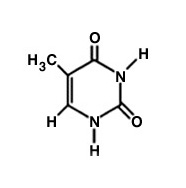
Diagram of the chemical structure of thymine, one of the four nitrogenous bases in DNA.
|
thymine - one of the four bases in DNA that make up the letters ATGC, thymine is the "T". The others are adenine, guanine, and cytosine. Thymine always pairs with adenine |
tidal channel - a channel that dissects the tidal flat surface. It is formed and maintained by tidal currents |
tidal current - a horizontal movement of the water caused by gravitational interactions between the Sun, Moon, and Earth |
tidal delta - a delta formed at both sides of a tidal inlet |
tidal flat - a marsh or sandy or muddy coastal flatland which is covered and uncovered by the rise and fall of the tide |
tidal inlet - a waterway from the open ocean into a lagoon |

A tidal pool. The seawater is replemnished with each incoming tide. Tidal pools provide a unique habitat for some fishes and invertebrates (Photo: Albert E. Theberge, NOAA)
|
tidal pool - an area in the littoral zone that retains sea water at a low tide because of a depression or arrangement of rocky substrate |
tidal range - the difference in water level between successive high and low tides |
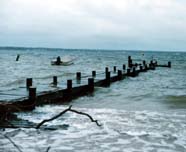
High tide combined with a storm threaten a pier. (Photo: Mary Hollinger)
|
tide - the periodic rising and falling of the water that results from the gravitational attraction of the moon and sun acting on the rotating earth |
tide gauge - a device for measuring the height (rise and fall) of the tide; especially an instrument for automatically making a continuous graphic record of tide height versus time |
tide tables - tables which give daily predictions of the times and heights of high and low waters. These predictions are usually supplemented by tidal differences and constants through which predictions can be obtained for numerous other locations |
tidelands - the zone between the mean high water and mean low water lines. It is identical with intertidal zone (technical definition) when the type of tide is semi-diurnal or diurnal |
TIFF (Tag Image File Format) - a common format for exchanging raster graphics (bitmap) images between application programs, including those used for scanner images |
time lapse photography - a photographic process in which a series of photographs are taken of the same basic scene at regular, timed intervals from the same viewpoint |
time zone - a region of the Earth that has adopted the same standard time, usually referred to as the local time. Most adjacent time zones are exactly one hour apart, and by convention compute their local time as an offset from Greenwich Mean Time (GMT) |
tinctorial - relating to staining or coloring |
Tisler Reef - a deep water Lophelia reef located in the Skagerrak, the submarine border between Norway and Sweden, at depths of 74 to 155 m. It has the world's only known yellow Lophelia pertusa corals |
tissue - a group of cells with a specific function in the body of an organism. Tissues are composed of nearly identical cells and their products, and are organized into larger units called organs |
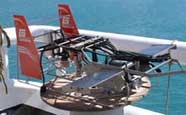
A towed optical assessment (TOAD) device is used to record bottom characteristics (Photo: NOAA)
|
TOAD (Towed Optical Assessment Device) - a device employing videography used chiefly at night on the NOWRAMP cruises to the Northwestern Hawaiian Islands. TOAD consists of a video camera and lights on a frame designed to be towed just above the substrate. The video is used to certify or ground truth acoustic habitat sensing. Specifically, the TOAD videos show the composition of the bottom in a few locations, such as sand, rubble, sea grass, coral, etc. It allows interpretation of broad area acoustic data by comparing it to the video information |
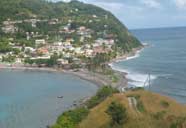
a tombolo connects the small island with the mainland of a larger island, Dominica, in the West Indies. The Atlantic ocean is to the right of the tombolo, and the Caribbean Sea is to the left.
|
tombolo - a land form such as a spit or bar which forms an isthmus between an island and a mainland shore, or between two islands |
topodeme - a deme (a local interbreeding population) occupying any specified geographical area |
topographic map - a map containing contours indicating lines of equal surface elevation (relief) |
topography - the set of natural or man-made physical features found on a map or chart of a region, such as mountains, valleys, bridges, and the shapes of landforms. A topographic map is a two-dimensional map portraying three-dimensional landforms; the relief features or surface configuration of an area |
topology - the branching sequence of a phylogenetic tree |
topotype - in taxonomy, a specimen collected at the type locality |
topotypical population - in taxonomy, a population occurring at the type locality |
topsentin - a marine pharmaceutical extracted from the sponges Topsentia genitrix, Hexadella sp., and Spongosorites sp. The topsentin family of compounds possesses potent anti-inflammatory properties |
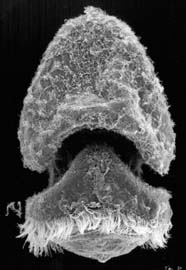
Young tornaria of Balanoglossus biminiensis. (Photo: University of Saskatchewan Archives)
|
tornaria larva - a ciliated, free-swimming pelagic larva of a hemichordate |
torsion - twisting of the body during development so that the posterior of the body takes an anterior position over the head |
totipotent - the state of a cell that has the potential to develop into any and all adult cell types as compared with a differentiated cell whose fate is determined |
towfish - an instrument, e.g., a side scan sonar, towed behind a ship |
toxicant - any substance which is potentially toxic |
toxicity - the action of poisons, including xenobiotics, on biochemical reactions or processes in living organisms or ecological systems |
toxicology - the scientific discipline involving the study of the actual or potential danger presented by the harmful effects of substances (poisons) on living organisms and ecosystems, of the relationship of such harmful effects to exposure, and of the mechanisms of action, diagnosis, prevention and treatment of intoxications |
trabeculum - in corallites, one of many rods or axial structures composed of fibrous tufts (sclerodermites), which form teeth along the upper septal margin |
trace - in biology or ichnology, a visible mark (as a track, trail, burrow) left by the passage of an animal; in chemistry, an unmeasureable or insignificant quantity |
trace fossil - a sedimentary structure consisting of a fossilized track, trail, burrow, tube, or other impressions or depressions left from the life activities of an animal, plant, insect, or natural force that has been preserved in soft sediment and lithified to solid rock; Any indication of prehistoric organic activity, such as tracks, trails, burrows, or nests; also called ichnite or ichnofossil |
trace fossil classification - a classification system that parallels the Linneaean taxonomic classification of organisms. In trace fossil nomenclature, a binomial is used, with a genus and specific epithet. With trace fossils, the genus is called an ichnogenus, and the species is an ichnospecies. The name is similarly italicized, and in full reference to the author plus the year of publication should be cited. "Ichnogenus" and "ichnospecies" are commonly abbreviated as "igen." and "isp.", respectively |
trade winds - a system of relatively constant low level winds that occur in the tropics. The trade winds blow from the northeast to the equator in the Northern Hemisphere and from the southeast to the equator in the Southern Hemisphere |
transcription - the process by which the genetic information encoded in a linear sequence of nucleotides in one strand of DNA is copied into an exactly complementary sequence of mRNA (messenger RNA). The mRNA then carries this information to the cytoplasm of the cell, where it serves as the blueprint for the manufacture of a specific protein |

Split beam transducer receives echoes with four different quadrants (Graphic: American Fisheries Society)
|
transducer - the electromechanical component of a sonar system that is mounted underwater and converts electrical energy to sound energy and vice versa |
transduction - transfer of genetic material from one cell to another by means of a virus or phage vector |
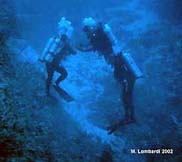
NOAA divers collect data along a transect line.
|
transect - a line used to survey the distribution of organisms or substrate across a given area. Sample plots or points are established along the transect for collecting data |
transfection - infection of a cell with nucleic acid from a virus, resulting in replication of the complete virus; gene transfer into eukaryotic cells |
transforming gene - a gene that causes normal cells to change into cancerous tumor cells; also called an 'oncogene' |
transgenic - having genetic material (DNA) from another species. This term can be applied to an organism that has genes from another organism |
transient - species or population that migrates through a given area, but does not breed or "winter" there |
transient aggregation - an aggregation characterized by individuals that migrate over long distances and over a short reproductive season |
transition - in molecular biology, a nucleotide substitution from one purine to another purine, or from one pyramidine to another pyramidine |
translation - in genetics, the process whereby genetic information coded in mRNA (messenger RNA) directs the formation of a specific protein at a ribosome in the cytoplasm |
transmissometer - an instrument for measuring transmission of light through a fluid |
transpiration - the loss of water vapor from a plant to the outside atmosphere, mainly through the stomata of leaves and the lenticels of stems |
transport - an exchange of molecules (and their kinetic energy and momentum) across the boundary between adjacent layers of a fluid or across cell membranes |
transposon - a short DNA sequence that has the ability to move from one chromosomal position to another one in the genome, a process called transposition ; also known as "jumping gene" |
transversion - in molecular biology, a nucleotide substitution from a purine to a pyramidine, or vice versa |
trap - a portable, enclosed device with one or more gates or entrances and one or more lines attached to surface floats; also called a pot |
trauma - any sudden physical injury or damage to an organism caused by an external force or violence. trauma is also used to describe severe emotional or psychological shock or distress |
traumagenic device - any part of an organism which is concerned with the causation of physical injury to another, such as teeth, spines, darts, rasping organs, beak bites, etc |
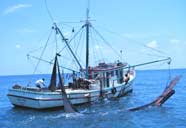
a double-rigged shrimp trawler with bag of one net on board (Photo: NOAA)
|
trawler - a fishing vessel that tows an open-mouthed fishing net drawn along the sea bottom or in the water column |
trench - a deep steep-sided depression in the ocean floor caused by the subduction of oceanic crust beneath either other oceanic crust or continental crust |
trial and error learning - a form of associative learning. trial and error learning occurs when an animal connects its own behavior with a particular environmental response. If the response has a positive reinforcement, or it is favorable to the animal, the animal will repeat the behavior in order to receive the same response again, possibly to receive a reward. If the response is unfavorable, such as causing pain, the animal will avoid the behavior |
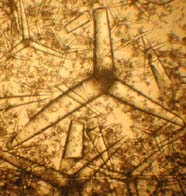
Microscopic triaxon spicules in a sponge. (Photo: NOAA)
|
triaxon - in sponges, a spicule with three rays |
tribe - a taxonomic group that is between a genus and a subfamily |
tributyltin (TBT) - a component of antifouling paints used on the hulls of vessels which may pose a threat to coral reefs. Contamination by TBT can significantly reduce coral recruitment in the area of a vessel grounding, and may consequently hinder recovery of the coral reef community TBT-based paints have been banned for use on small craft, but TBT-based paints are still widely used on large ships which navigate routes that pass through coral reef habitat |
trichocyst - a stinging or grasping organelle in the outer cytoplasm of protists, especially ciliates. It consisting of a hair-like filament that can be discharged suddenly from a minute capsule |
trichogyne - receptive elongation of the carpogonium (female reproductive structure) in red algae where male gametes become attached |
trifurcate - dividing into three parts |
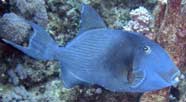
The blue triggerfish (Pseudobalistes fuscus) in Hurghada, Red Sea. (Photo:Thomas Jundt)
|
triggerfish - any of several species of tropical coral reef fishes in the order Tetraodontiformes, family Balistidae, with laterally compressed bodies, heavy scales, and tough skins. triggerfishes are named for the mechanism of the three spines of their first dorsal fin. When the fish is alarmed the first of these spines is locked upright by the second and drops only when the latter is pressed like a trigger. The function of this reaction is to lock the fish firmly in a mass of coral when attacked. triggerfishes have powerful, chisel-like teeth adapted for cracking the coral and mollusks upon which they feed |
triglyceride - a complex molecule which is the main component of dietary and body fat. It is made up of a combination of glycerol and three fatty acids |
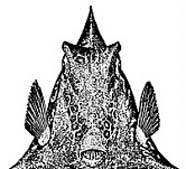
The trihedral shape of a trunkfish as it swims directly toward the viewer (Illustration: NOAA)
|
trihedral - with three surfaces, e.g. the body of a trunkfish |
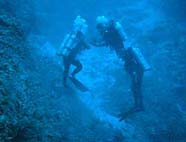
Marine scientists breathing trimix working on a transect line in order to collect sponge and water samples at a depth of approximately 60 m (200 ft). (Photo: NOAA National Undersea Research Program)
|
trimix - a breathing gas mixture of helium, oxygen, and nitrogen. By using trimix, it is possible for divers to descend to hundreds of feet without suffering from toxic partial pressures of oxygen (which increases with depth), and also reduces the effect of nitrogen narcosis |
trinomen - in taxonomy, the combination of a generic name, a specific name, and a subspecific name, that together constitute a scientific name subspecies |
triplet - in genetics, a sequence of three nucleotides of DNA which specifies an amino acid. |
triploid - a polyploid having three sets of homologous chromosomes |
tripton - the nonliving particulate matter in bodies of water |
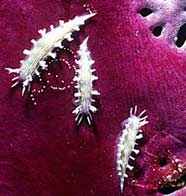
This relatively small Caribbean tritoniid (tritonia hamnerorum) feeds exclusively on gorgonian sea fans and is sometimes found in large numbers. (Photo: Bill Rudman)
|
tritoniid - a member of a family of nudibranchs (tritoniidae) which feed on soft corals, gorgonians, and other anthozoans. A characteristic common to the tritoniids are the dorsilateral branched cerata, used as gills and located in the edges of the dorsal surface |
triturate - to grind or masticate |
trNA (transfer RNA) - short-chain RNA molecules present in the cell, in at least 20 varieties. Each variety is capable of combining with a specific amino acid, and attaches the correct amino acid to the protein chain that is being synthesized at the ribosome of the cell, according to instructions coded in the mRNA |
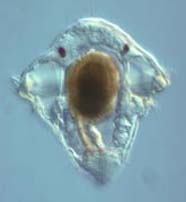
The trochophore larva of a marine worm. (Photo: University of Saskatchewan Archives)
|
trochophore larva - the ciliated planktonic larva of many invertebrates, including polychaete worms, mollusks, and rotifers |
trochus - a genus of medium-sized to very large marine gastropods (snails) in the family trochidae. trochus niloticus, for example, is a very large (up to 16 cm) Indo-Pacific species, which has a very thick inner layer of nacre. This species has been commercially exploited to make mother of pearl buttons, mother of pearl beads, pendants, and other products. They inhabit intertidal and shallow subtidal areas of coral reefs. trochus sp. can be distinguished from most other gastropods in having a conical shell. All species are herbivorous. A common name for the trochids is "top shell" |
troglobite - an obligate cave dweller |
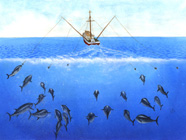
Fishing vessel trolling for tuna. (Graphic: NOAA)
|
trolling - a fishing method where lures or baits attached to lines are towed behind a slowly moving boat |
trophic - related to or functioning in nutrition |
trophic dynamics - the complex biological processes whereby energy and matter are passed up to successive levels of food webs |
trophic group - a group of organisms consuming resources from a similar level in the energy cycle |
trophic level - a classification system of organisms according to their means of obtaining nutrition. A segment of the food chain in which all organisms obtain food and energy in basically the same manner (e.g., photosynthesis, herbivory, or carnivory) and in which all organisms are the same number of links from the photosynthetic segment |
trophosome - a collective term for all nonreproductive structures of colonial hydrozoans; a structure in beard worms (Polychaeta-Siboglinidae)that harbors commensalistic chemosynthetic bacteria in cells called bacteriocytes |
tropical - region in which the climate undergoes little seasonal change in either temperature or rainfall. tropical regions of the earth lie primarily between 30 degrees north and south of the equator |
tropical depression - a mass of thunderstorms and clouds generally with a cyclonic wind circulation of between 20 and 34 knots |
tropical disturbance - an organized mass of thunderstorms with a slight cyclonic wind circulation of less than 20 knots |
tropical Ocean Coral Bleaching Indices - indices of selected coral reef sites/regions (maintained by NOAA/NESDIS) that present satellite-obtained measurements of relevance to coral reef ecosystems |
tropical storm - a tropical cyclone with maximum winds less than 34 m/sec (75 mile per hour) |
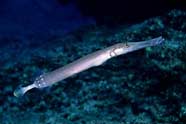
The trumpetfish is a common reef fish. It feeds on other reef fishes. (Photo: Keoki and Yuko Stender)
|
trumpetfish - any of a family of tropical reef fishes (Aulostomidae), recognised by its long body, tubular snout with minute teeth, its chin barbel, and a series of short dorsal spines. A carnivore, It often approaches its prey vertically, darting down from above and sucking the prey into its long snout |
truncate - having the end squared off |

The spotted trunkfish, Lactophrys bicaudalis.(Illustration: NOAA)
|
trunkfish - any fish species in the family Ostraciidae (order Tetraodontiformes). trunkfishes are encased in an triangular inflexible bony carapace which protects them from predators.Only the jaw, eyes, the bases of the fins, and the caudal fin protrude from this carapace They are slow swimmers that move primarily by sculling with their dorsal and anal fins and use their caudal fin for sudden bursts of speed. They are also known as boxfishes or cowfishes |
trust territory - a colony or territory placed under the administration of one or more countries by commission of the United Nations |
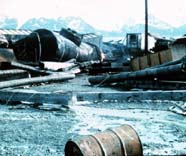
Tsunami damage at Seward, Alaska, following 1964 Good Friday Earthquake. (Photo: NOAA)
|
tsunami - a long-period gravity wave generated by a submarine earthquake or volcanic event |
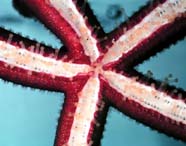
The ventral side of a Pacific starfish shows its tube feet.
|
tube feet - extensions of the water-vascular system of echinoderms, protruding from the body and often ending in suckers. They may be used for locomotion and/or for maintaining a tight grip on prey or on the substrate |
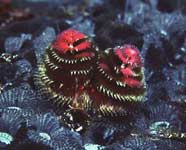
The Christmas tree worm, S pirobranchus giganteus,is a tube worm that inhabits coral reefs (Photo: Keoki and Yuko Stender)
|
tube worm - a marine worm in the phylum Annelida, class Polychaeta, that lives within tubular cases made of mineral or chitinous secretions or of aggregated grit. Other worm-like invertebrates in the phyla Pogonophora and Phoronida have also been referred to as tubeworms |
tubercle - any small, usually hard, knobby excrescence or lump. In pycnogonids and some cheliceramorph arthropods, the central eyes are carried on a tubercle |
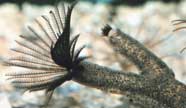
a sabellid tube worm lives it life in a parchment tube (Photo:Dr James McVey/NOAA)
|
tubicolous - inhabiting a tube or tubular structure; tube dwelling, such as some marine polychaete worms |

The trumpetfish has a snout which is tubiform or tubular in shape. (Photo: Copyright Digital Stock Corp.)
|
tubiform - a shape resembling a tube |
tubules of Cuvier - eversible toxic or sticky tubules associated with the bases of the respiratory trees of some sea cucumbers (Holothuroidea-Echinodermata) |
tumid - swollen, inflated. |
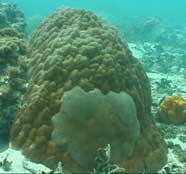
A coral (Porites lutea) with a tumor (Photo: CNMI/Coastal Resources management)
|
tumor - a mass of new tissue, with no useful physiological function, growing independently of its surroundings |
tumorigenesis - the production or formation of tumors |
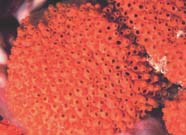
Orange colonial tunicate at Gray's Reef National Marine Sanctuary. Each of the individual tunicate's body is covered by the tunic. (Photo: NOAA)
|
tunic - the outer covering of a tunicate (Urochordata). The tunic is mostly composed of a protein and carbohydrates |
Turbellaria - a class of generally small and free-living members of the flatworm phylum Platyhelminthes. Classification within the Turbellaria is in a state of flux as it is unclear whether the class is truly monophyletic. Most are marine and benthic, but some also inhabit fresh water and moist temperate and tropical terrestrial habitats. Most members of class are predatory on small invertebrates; the rest are herbivores, ectoparasites, or scavengers. Many coral reef-inhabiting turbellarians in the order Polycladida are very colorful |
turbidimeter - an instrument for measuring turbidity of liquids |
turbidity - cloudy water, usually caused by the suspension of fine particles in the water column. The particles may be inorganic, such as silt, or organic, such as high densities of single-celled organisms |
turbidity current - a current of of rapidly moving, sediment-laden water moving down a slope through air, water, or another fluid. The current moves because it has a higher density and turbidity than the fluid through which it flows |
turbidity flow - a flow of dense, muddy water moving down a slope due to a turbidity current |
turbinate - resembling an inverted cone |
turquoise - blue green color |
twilight - the time immediately before sunrise and after sunset when the sky remains illuminated |
twilight zone - the term, "twilight zone" represents a transition from a region that receives sunlight during the daylight hours, to a region that remains in perpetual darkness. The coral-reef twilight zone is roughly defined as coral-reef habitat at depths between about 200 feet (60 meters) and 500 feet (150 meters). The upper limit represents the approximate maximum depth to which stony corals tend to dominate the reef structure, and the lower limit represents the maximum depth at which significant photosynthesis occurs (the maximum depth to which the living coral reef extends) |
tympaniform - drum-shaped |
type - in taxonomy, the standard of reference for determining the precise application of a name. Each taxon has, actually or potentially, a type: type of a nominal species is a specimen (type specimen or holotype); type of a nominal genus is the nominal species (type species); type of a nominal family is the nominal genus (type genus) |
type collection - in taxonomy, a collection of type specimens |
Type I error - the error of rejecting the null hypothesis when it is true |
Type II error - the error of not rejecting the null hypothesis when it is false |
type locality - in taxonomy, the geographical (and, where relevant, stratigraphical) location of the occurrence of the population from which the type specimen (i.e. holotype, lectotype or neotype) was taken |
type material - in taxonomy, a collective term for all type specimens |
type series - in taxonomy, the series of specimens which either constitutes the name-bearing type (syntypes) of a nominal species or subspecies or from which the name-bearing type has been or may be designated |
type species - in taxonomy, the nominal species that is the name-bearing type of a nominal genus or subgenus |
type specimen - in taxonomy, any specimen of the type series |

A satellite view of a typhoon in the western Pacific ocean (Image: NOAA)
|
typhoon - a hurricane that forms in the western Pacific Ocean |
typological species - a species defined on the characters of the type specimen; a group of organisms in which individuals are members of the species if they conform to certain fixed properties |
|
|
|
|

